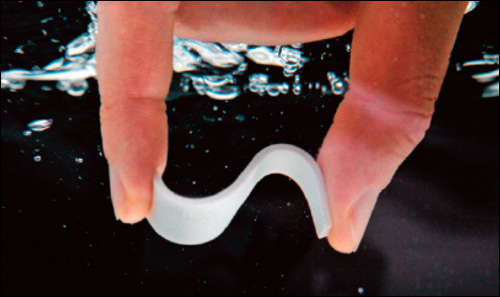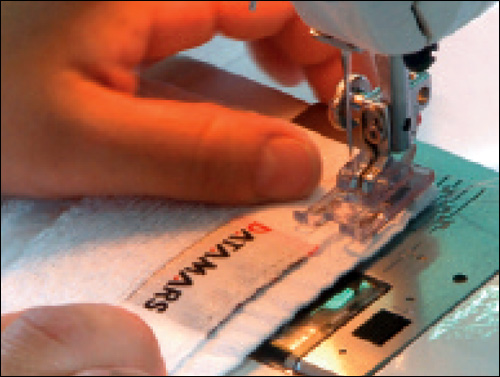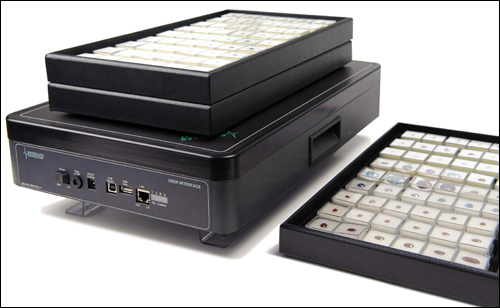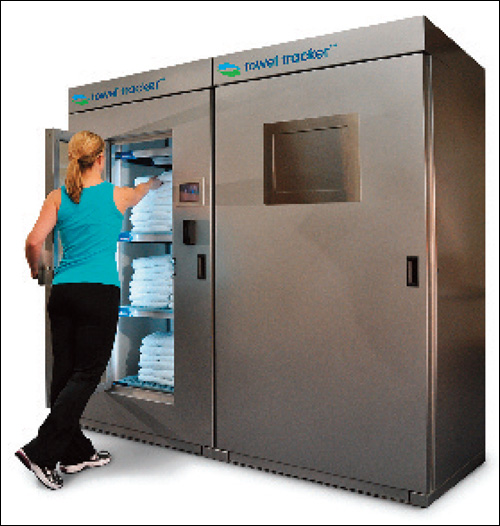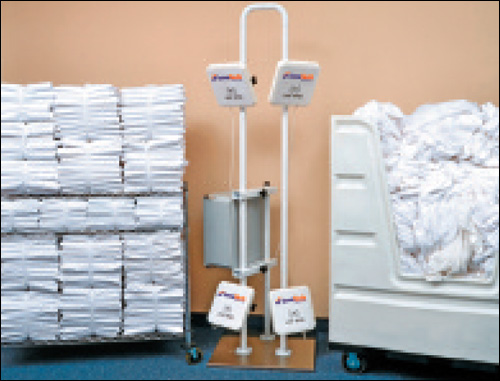Feb 19, 2016An Active RFID Solution for Aerospace Companies
V-Tag can make it easy and cost-effective to track assets and work-in-process at large facilities.
A U.S. aerospace company that makes specialty products for commercial and military aviation manufacturers worldwide, including Boeing and Lockheed Martin, had a problem. The company typically uses fixtures and tooling owned by customers and is required to account for them. Last year, it adopted the RFID V-Tag solution from ID Integration and InfinID Technologies to monitor some 3,000 to 4,000 tools at a 250,000-square-foot manufacturing plant.
V-Tag offers a complete solution that is designed for easy deployment, says Peter Ginkel, ID Integration's VP of marketing and business development. Items are identified with active V-Tag asset tags, which transmit 2.4 GHz signals over a proprietary air-interface protocol. The asset tags communicate with V-Tag fixed tags, which can be attached to ceilings, walls or pillars, and the location of each fixed tag is stored in AssetWorx! software, which is part of the V-Tag solution.
The tags on moving assets create a wireless mesh network that transmits location data to a gateway reader installed within the vicinity. The software displays an asset tag's location on a map of the facility, based on which fixed tags received the asset tag's signal and also on the signal's strength, as received by the fixed tags.
The aerospace company is RFID-tracking the location of jigs and fixtures used in the production of its products, Ginkel says. "Since customer-owned tools are valuable assets, they are subject to auditing by the customers," he explains. At any given time, the tooling can be located in the main storage area, on the shop floor in production, and in calibration or other maintenance and rework locations, he says.
"Accounting for the tooling makes the auditors happy, saves significant time and insures that the company maintains a high rating by their customer purchasing and financial departments," he adds.
Another company that provides maintenance, repair and operations (MRO) services to aircraft companies is using the V-Tag solution to monitor work-in process. The company needs flexibility to change its workflow for each customer. Factory production floors are frequently reconfigured to facilitate product flow and optimize production, Ginkel says. With V-Tag, fixed tags can be attached with Velcro, and easily relocated to accommodate any revised factory floor arrangement, he says.
While battery-operated tags typically cost more than passive tags, Ginkel says the V-Tag solution is cost-effective because it avoids the time and expense of setting up a passive infrastructure, which includes wiring, cabling and labor, as well as the involvement of plant engineering and safety departments. A V-Tag network can be installed at a large factory in just a few days, he says.
A V-Tag installation typically is priced at one-quarter to one-half of traditional passive tag installations, Ginkel says. "We are finding that budget money is more readily obtainable by nontraditional RFID customers," he says. "A full-blown passive network in a multihundred-thousand-square-foot factory is typically an impressive and intimidating expense. At customers we have worked with, it is unlikely they would have been able to secure the funding to install a passive RFID system."
The V-Tag battery has a three-year life, and InfinID is testing a six-year battery, says Gary Moe, ID Integration's president. "Our customers are fine with replacing batteries when looking at the cost savings and flexibility over a passive solution," he says. "The V-Tag reports back when the battery level is getting low, so the customer knows when to replace a battery."
Still, it's often more economical to identify hand tools and other low-value items with passive tags. The AssetWorx! software can also accommodate input from passive RFID tags and bar-code scanners. "A simple passive gateway at the entrance to a tool crib can account for those passive tagged items," Ginkel says.
A cost/benefit analysis can determine whether a passive or active V-Tag solution is most appropriate, Ginkel says. "A factory with traditional assembly lines that constrain products to defined paths may not be optimal for active RFID technology," he says. "But in hybrid applications, the best properties of the different RFID technologies work together."
Paving a Path to Adoption for Retailers
Combining RFID with EAS provides a lower-cost way to trial item-level tracking to improve inventory management.
Many department store and specialty retailers employ electronic article surveillance (EAS) technology to help combat the theft of goods. Now, they're thinking of using RFID to address another big concern—poor inventory management. But they are wary of the migration path in terms of time and cost, says Uwe Sydon, senior VP of innovation at Checkpoint Systems.
In October, Checkpoint introduced its UNO Series of labels, aimed at addressing those issues. "Both RF and RFID technologies are on the same substrate in a single tag," says Umesh Cooduvalli, Checkpoint's senior director for RFID consumables. "This reduces the tag implementation costs of using two different tags—EAS and RFID—and provides for a smooth transition to RFID for retailers." Our EAS customers, he adds, can continue to use their EAS infrastructure for loss prevention and begin to use RFID for inventory management.
Retailers would still need to purchase fixed or handheld readers, depending on their budgets, to interrogate the tags, Cooduvalli says. Any inventory-management software will work fine, he adds, "but we prefer and suggest OAT software." (OATSystems is a division of Checkpoint.)
The UNO Series incorporates Ucode 7 chips from NXP. The Ucode 7 is an ultrahigh-frequency RFID integrated circuit that increases read and write performance. In 2007, Checkpoint attempted the dual-technology approach with Evolve labels. With the UNO series, Cooduvalli says, Checkpoint has leveraged huge advancements in integrated chip technology to improve performance significantly.
The UNO labels are available in both rectangle and square form factors. They are designed to meet packaging and marketing requirements, Cooduvalli says. Some customers are using the product with a clear face sheet (instead of a paper face), so the label is less intrusive on packaging for cosmetics and other products, he says. In the health, beauty and cosmetics categories, each store typically has more than 350 stock-keeping units, he says, and roughly 30 percent of these, including small items, can use the UNO Series. But EAS labels do not work on metal.
Others, such as apparel retailers, use the paper-face sheet labels so they can print price information on the labels. "Some of them also convert them into fully integrated tickets and hangtags," Cooduvalli says. The UNO Series is designed to support a variety of RFID reader frequencies, by providing greater broadband. This means that regardless of a product's point of manufacture or its destination location, the label will perform reliably, according to the company. "Different regions operate within different frequencies," Cooduvalli says. "Some tags are designed and tuned specifically to either Europe or the United States. But the UNO design is universal and provides optimal performance in both regions."
A health and beauty retailer that has been using Checkpoint's EAS system decided to adopt the UNO labels because "it was cheaper and faster to leverage [the solution] using the infrastructure they already have with hundreds of stores," Cooduvalli says. The retailer reports that accurate inventory visibility has enabled the company to cut its inventory counts and still improve out-of-stock metrics, he says.
Mobile App Keeps Cold-Chain Customers Informed
DHL's LifeTrack solution for smartphones and tablets lets users track their shipments in real time and receive immediate alerts.
Monitoring the condition of temperature-sensitive pharmaceuticals, biomedical supplies and other life-sciences products while they are in transit or storage is essential. It ensures the safety and efficacy of products that can impact patients' health, and enables companies to meet government regulations.
DHL Global Forwarding, the air and ocean freight specialist of the Deutsche Post DHL Group, launched its LifeTrack solution in 2006, to track the location and condition of cargo as it travels through the supply chain. A dedicated DHL team monitors each shipment throughout every stage of transportation, says David Bang, global head of DHL Temperature Management Solutions and CEO of DHL's LifeConEx. "We are able to take direct action when a concern is highlighted," he adds, "including working with our ground personnel as well as partners such as airlines and truckers."
Today, more than 100 companies worldwide use LifeTrack to monitor their shipments, Bang says. The solution includes Web-based software, so companies can log in to a secure, cloud-based site and access real-time information on the status of their shipments. Should a major issue occur, customers get automated e-mail alerts, as well as notices of any interventions and shipment resolutions, he says. "For certain critical decisions, emergency contacts from customers get contacted, too," Bang adds.
But like many businesspeople, DHL customers are often on the move—and on their mobile devices. So, in December, DHL introduced the LifeTrack Mobile App, which allows iOS and Android smartphone and tablet users to access the same capabilities from their mobile devices.
Customers who didn't have easy access to alerts now receive them immediately on their devices, Bang says. They can select or "favorite" a particular lane—the logistical path from the shipping origin to the final customer destination—and particular product cargo, and track all the logistical events that occur as the cargo moves through the chain. And they can contact DHL's support team 24/7 directly from the app.
The new mobile app is an extension of LifeTrack that customers have been asking for, Bang says. "A major driver for this comes from meeting customer needs," he says. Employees at health-care and pharmaceuticals companies wanted mobile access to provide greater flexibility in their lifestyle and work schedules.
DHL is still gathering data on how many customers are using the app. "However," Bang says, "some early customer feedback has been positive so far." A Swedish customer that is a leader in the area of HIV monitoring, for example, said: "From our company perspective, it is crucial that you get informed when there are issues [occurring], especially when transporting frozen goods." The customer cited the app's "issue-reporting" feature, because it easily distinguishes major from minor issues and provides clear status updates on resolution, Bang says.



